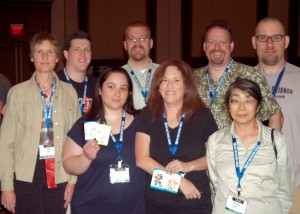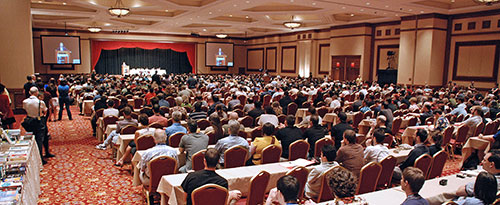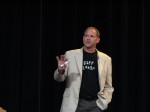Thumbs Up For The Amazing Meeting 7 and A Few Bits of Wisdom
Posted July 15, 2009
I attend several conferences each year. Those which are not academic are usually organized by “skeptic” organizations, groups which promote critical thinking, debunk myths, and reveal scams, especially pseudoscience. The Skeptic Society offers a short (Friday night through Sunday morning) conference in Pasadena about every other year. The talks usually address questions on a scientific topic which is considered controversial to the general public such as the state of the environment or the origins of life.

Last Weekend I attended the 7th annual Amazing Meeting [TAM7] in Las Vegas. The meeting, held by the James Randi Educational Foundation [JREF], is attended by skeptics from all over the globe and for good reason. It is so popular that the first non-U.S. meeting, which is scheduled for October of this year, has been sold out since May.
I highly recommend this conference for all critical thinkers. Speakers, including the “regulars” tend to be among the brightest minds and many are highly entertaining, too. It is a place to discuss and debate controversial subjects without fear of offending others. You will learn about everything from the paranormal to conspiracy theories to alien abduction and what you can do to educate others. It will anger you and inspire you to be an agent of change. It is a place to network with other skeptically-minded people and join forces to fight woo. The Critical Thinking Education Group [CTEG] was formed at last year’s TAM and we attempted to expand our numbers with a little bit of advertising this year. It is fun, it is family, and it is, in short, AMAZING. Next year’s meeting [TAM8] will be held July 7 — 11, 2009 at the South Point Casino, Hotel, & Spa, so mark your calendars now!
For those who have never attended a meeting of skeptics, there are some notable similarities to other types of conferences as well as some notable differences. Unlike most academic and professional meetings, there is generally only one event going on at a time. This means that there are very few talks (and very few speakers), but they are almost all invited talks rather than reviewed submissions (more on that later). Talks are given in a ballroom or auditorium. Invited speakers tend to stick around and attend the talks they do not give. They usually socialize with the other attendees, many of which are friends and some of which are simply fans, but they do so with enthusiasm. Everyone shares at least some meals.
Like academic and professional meetings, optional evening events are available including parties, shows, and fundraisers. For example, each year Penn and Teller, fellow skeptics and good friends of the Amazing Randi, offer tickets to their show at a discounted price for TAM attendees.
Despite the economic crisis, this year’s attendance was the highest ever at over 1,000. In fact, I believe it is as big as a conference of its kind can get without making unwanted changes to the format. In addition, the organizers streamed the conference using ustream.com. Although they did not announce this until the conference was underway, more than 18,000 people had viewed at least part of the conference by Saturday afternoon. One contributing factor was the reliable internet access we all had in the conference area. Many attendees posted links on facebook and Twitter for those unable to attend. In fact, I interacted with people in the room via facebook and email without even knowing where many of them were sitting, and together we interacted with people streaming the conference online. It actually makes me a bit dizzy just thinking about it.
The Skeptic’s Guide to the Universe entertained us at breakfast Friday and Saturday mornings and Hal Bidlack, as usual, was our emcee for the weekend. The keynote speaker, Bill Prady, gave us an entertaining account of how his show, the Big Bang Theory, relates to science in the real world (and sometimes does not relate). But you can see the speaker schedule for yourself. I’ll just hit my favorites here.
One of the highlights of the day for me was the Anti-anti-vaxx Panel. Unless this is your first time reading this blog, you know that vaccination scaremongering is something I feel very strongly about. Three of Science-Based Medicine’s authors were on the panel. Steven Novella and Harriet Hall are two of the most well-respected doctors in skeptic circles and Joe Albeitz organized a drive for donations to vaccinate children in the Las Vegas area which raised over $8,000 — enough to provide vaccinations for 500 children. Michael Goudeau contributed a great deal, too, as the intelligent parent of an autistic child. Rounding out the panel was the last-minute addition of Derek Bartholomaus, whose jennymccarthybodycount.com, created in his spare time, is a testimony to the power of the individual.
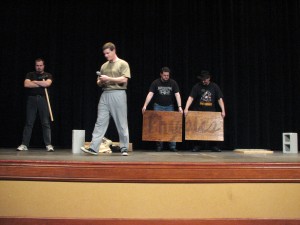
The Skeptical Teacher getting ready to lie between two beds of nails. The sledgehammer you see in the background is also involved. DON’T TRY THIS AT HOME! Photo by Dean Baird
On Saturday Michael Shermer spoke about a topic I hope to cover soon on this blog: political viewpoints and skepticism. Shermer has received a great deal of criticism for simply discussing this issue and I admire him for doing so in spite of that. The first half of this talk included some hilarious descriptions of how each of the two major political parties view the world and each other that everyone enjoyed. After that, the room became a little tense, but I think it is a good tension. I certainly do not agree with him on every point, but we need to have a dialogue because if anyone can solve our economic issues, it will be the rational among us. See below for a link to his recap.
Mythbusters’ Adam Savage never ceases to amaze me in the way that he can turn a personal story that we should find excruciatingly boring into an engaging discussion. He discussed failure, but what he was really talking about was the willingness to take responsibility for one’s choices and actions and the way in which that willingness leads to success.
As in past years, Penn and Teller joined others in panel discussions about magic and media. Phil Plait, the Bad Astronomer and JREF president, revealed what he was able to learn about the 2012 end-of-days cries.
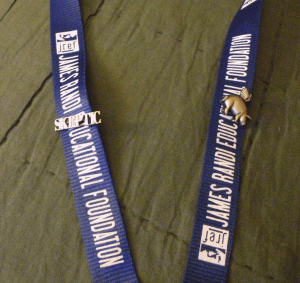 As always, there were a few opportunities to shop. JREF and the Skeptic Society were among those selling books, DVDs, CDs, and even science-related toys. I picked up some mirror-driven “hologram” makers for my kids and a cute stuffed neuron for myself from JREF. I also purchased a couple of Skeptic lapel pins from the Skeptic Society as I do at every event at which they are sold (I have lost more of these than I can recall) and two pigasus pins from JREF. Oragami pigasuses (or is it pigasi?) were all the rage last year, so Richard Saunders of the Skeptic Zone, a podcast produced in Australia, brought earrings made from tiny versions of the creature! I supported our Aussie colleagues by purchasing a DVD-ROM of origami instruction videos (Saunders has written several origami books). All of these groups use the proceeds to support their education efforts.
As always, there were a few opportunities to shop. JREF and the Skeptic Society were among those selling books, DVDs, CDs, and even science-related toys. I picked up some mirror-driven “hologram” makers for my kids and a cute stuffed neuron for myself from JREF. I also purchased a couple of Skeptic lapel pins from the Skeptic Society as I do at every event at which they are sold (I have lost more of these than I can recall) and two pigasus pins from JREF. Oragami pigasuses (or is it pigasi?) were all the rage last year, so Richard Saunders of the Skeptic Zone, a podcast produced in Australia, brought earrings made from tiny versions of the creature! I supported our Aussie colleagues by purchasing a DVD-ROM of origami instruction videos (Saunders has written several origami books). All of these groups use the proceeds to support their education efforts.
On Sunday, there were paper presentations. These are the exception I noted above in that they are presented by those who have submitted proposals. The proposals are reviewed and only a few make the final schedule. There were several interesting talks by fellow skeptics including Brian Dunning of Skeptoid and Tim Farley of whatstheharm.net.
The conference wrapped up with a Million Dollar Challenge — live in front of about 700 people (by my eyeball estimate), with another 1700 streaming it. The challenge itself was pretty boring, but exciting at the same time. I imagine that the non-scientists watching now have some perspective into how UNglamorous research is; the findings are where all of the excitement lies. Knowing the significance of the event is the exciting part. We were all fairly certain of how things will turn out, but the true skeptic leaves the door slightly ajar and I think that most of us were rooting for Connie Sonne, the self-proclaimed dowser. However, as expected, she failed utterly. The task was to identify which of 10 cards matched the outcome of one roll of a die in 3 trials. She matched none. Although she was very professional at the test, she later claimed that Banachek, who administered the test, had cheated. So much for grace under pressure…
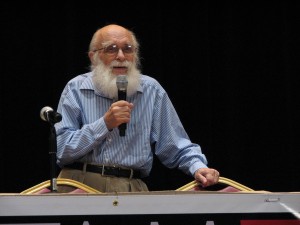
… and of course the man who puts the JR in JREF and the A in TAM, the Amazing Randi himself. Photo by Dean Baird
Before I could finish and post this entry, many TAM7 stories, recaps, and notes have been posted by other bloggers. They are well-worth reading…
Michael Shermer gives an overview of his talk on Skepticblog in addition to news of the rest of his weekend in Las Vegas.
Skepchick Rebecca Watson recounts how she ended up getting married one TAM7 morning in the middle of recording the SGU podcast. It includes a description of how TAMmers take over at the venue which has only become more true over the years. A video of the wedding can be seen at Bad Astronomy.
The Skeptical Teacher (see pic above) shares lessons learned at TAM7 workshops held at Thursday’s Science-Based Medicine Conference as does Orac at Respectful Insolence. Steven Novella does a play-by-play of the day on the Science-Based Medicine blogsite.
Steven Novella also discusses a topic on his NeuroLogica Blog which pops up at every TAM — skeptical activism and how volunteers drive this effort as well as what YOU can do to help.
If you would rather listen than read, Derek and Swoopy recount their experiences on the latest edition of the Skepticality podcast.
Finally, on Skepticblog Mark Edward tells the story of how Connie Sonne, the self-proclaimed psychic, failed the Million Dollar Challenge in front of a huge audience, but still thinks she’s psychic.
Comments for this page are closed.
